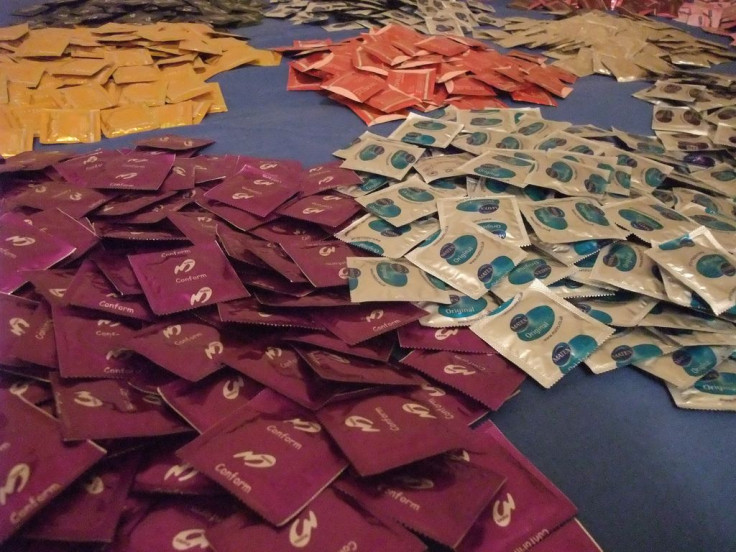Hypersexual Disorder Or Just A High Sex Drive? The Profile Of A Sex Addict

The urge to slip beneath the sheets and intertwine your body with your partner is human nature. No one can deny the euphoria of orgasm that overcomes your body from brain to genitals. It’s satisfying for some, but for others, it’s never enough. While everyone’s sex drive varies, when does the preoccupation with sexual fantasies and behavior turn from a high sex drive to addiction?
Sex Addiction In Pop Culture
Sex addiction, clinically known as hypersexual disorder, first came into the limelight when actor Michael Douglas spent time in rehab in the early 1990s for sex addiction. Douglas, along with celebrities like David Duchovny and Tiger Woods, have publicly come out to profess a sex addiction. Despite these testimonies and movies like Shame and Thanks For Sharing touching upon the taboo topic, many still perceive sex addiction as an excuse for “bad behavior.”
Science Gets Underneath It All
A gray area exists in the Diagnostic and Statistical Manual of Mental Disorders (DSM-V) on sex addiction, despite the 12 million people who suffer from it in the U.S., according to the American Association for Marriage and Family Therapy. The term “sexual addiction” first showed up in the DSM-III in 1980, but was removed in the 1994 edition due to lack of research. Now the DSM-V touches upon it, but very lightly, in a section on sexual disorders: “Research suggests that sexual response is not always a linear, uniform process and that the distinction between certain phases (e.g., desire and arousal) may be artificial.”
The lack of classification as a mental disorder may make sex addicts' partners believe they're in reason for perceiving it as an escape hatch for infidelity, but researchers contest it is a real disorder that has the possibility of ruining careers, destroying relationships, and even leading to further health problems.
Dr. Fran Walfish, Beverly Hills psychotherapist, author, and expert panelist on WE TV’s Sex Box, told Medical Daily that in her clinical experience, the majority of sex addicts she’s treated were very professional, wealthy men in a range of professions, who are respected in their fields of choice.
“Nobody knows about this private behavior,” she said. “You cannot tell by looking on the outside who has experienced these early traumas. It can be anyone walking among us.”
A 2012 study published in The Journal of Sexual Medicine supports the notion of sex addiction as a diagnosis-worthy disorder. The researchers evaluated the participants by measuring their hypersexuality, impulsivity, emotional deregulation, and stress proneness in relation to sex addiction. These patients reported excessive masturbation, use of pornography, cybersex, sex with prostitutes, affairs, and multiple anonymous partners, averaging 15 partners in the previous 12 months.
The team also proposed criteria for this disorder, which included a recurring pattern of symptoms, such as sexual fantasies, urges, and behaviors lasting a period of six months or longer not caused by other issues like substance abuse or another medical condition. Moreover, the researchers said individuals who might be diagnosed with this disorder must show a pattern of sexual activity in response to unpleasant mood states, or a pattern of repeatedly using sex to cope with stress.
Despite the proposed criteria, sex addiction is still not officially recognized, but brain scans may help bring it a step closer to medical acceptance.

The Brain Of A Sex Addict vs. The Brain Of A Drug Addict
Similarities between the brain of a sex addict and that of a drug addict, and the difference between the sex addict brain and that of a healthy sexual adult could not be defined until recently. A 2014 study published in the journal Neural Correlates of Sexual Cue Reactivity in Individuals with and without Compulsive Sexual Behaviours found brain activity in sex addicts mirrors brain activity in drug addicts when exposed to drug-related stimuli. When sex addicts viewed sexual imagery, three significant brain regions — the ventral striatum (processes rewards), the dorsal anterior cingulate (anticipates rewards), and the amygdala (processes the significance of events and emotions) — were similarly activated in drug addicts when exposed to drug-related imagery.
The addict brain is deficient in dopamine receptors. “This applies to all addictions: Drugs, alcohol, gambling, sex, shopping... [A]ddicts don't have an efficient ‘reward center’ and overstimulate themselves just to feel something,” Ethlie Ann Vare, a journalist, lecturer, and author of Love Addict: Sex, Romance and Other Dangerous Drugs, told Medical Daily in an email.
Sex, just like drugs, are quick dopamine enhancers. As a result, the more addicts “yell” at their dopamine receptors, according to Ethlie Ann, the “deafer” they become, meaning the greater the tolerance for the addiction in question.
She heard a sex addict say: "You try so hard to dull the pain and the shame that after a while, the only thing strong enough to get through the haze is the pain you're trying to anesthetize in the first place.”
In comparison to the brain of the sexually active adult, sex addicts become obsessively engaged in anticipatory fantasy — when any of us experiences desire or want. While the non-addict chooses or does not choose to be sexual, gamble, or use drugs, the addict will become fixated on this idea.
Robert Weiss, founder of The Sexual Recovery Institute in Los Angeles, Calif., addiction psychotherapist, and author of the upcoming book Always Turned On: Sex Addiction in the Digital Age, told Medical Daily in an email that for addicts, “this fantasy quickly turns to obsession, and the brain literally appears to ‘get stuck’ between a desire for highly pleasurable fantasy activity and the cognitive dissonance which occurs as they often simultaneously are thinking ‘I’m not sure I want to do this.’”
Uncovering A Bonafide Sex Addict
Back to the original question: How much sex separates someone with a high sex drive from a sex addict?
The answer is there is no magic number.
Addiction is not determined by quantity of use, but by quality of life. For example, how many drinks does it take to make an alcoholic? There is no answer to that.
“The addiction doesn’t have to do with the number of times someone has sex. It has to do with the boundaries involved in sex, as well as the disruption the behavior has on normal life,” April Masini, relationship expert and author, told Medical Daily in an email.
Like with any addiction, triggers are personal because they have to do with an individual’s history. Someone with an addictive personality will express their addiction through sex, substance abuse, or behaviors like shopping or gambling. Other times these triggers can be direct, such as seeing porn or other sexually stimulating images.
Weiss has seen adults with early attachment-related trauma such as emotional, physical, sexual abuse by a caregiver, inconsistent parenting, parental enmeshment, covert incest, and neglect among many others. As a result, many of these “at-risk” individuals turn to alcohol, painkillers, or even repetitive objectified sexual experiences, according to Weiss, as a way to self-medicate stress.
Early-life trauma has been proven to be a major factor in sexual addiction. A 2013 survey published in the Journal of Aggression, Maltreatment & Trauma found when self-identified addicts were asked about their childhoods, 38 percent reported emotional abuse, 17 percent reported sexual abuse, and 16 percent reported physical abuse.
“So rather than being ‘overly horny,’ ‘perverts,’ or simply people with a ‘high sex drive,’” Weiss said, “sex addicts are most often people who’ve been emotionally wounded, usually early and repeatedly, in ways that leave them feeling unworthy of love, affection, connection, and happiness.”
As children they end up with a distorted, shame-based sense of self, where they feel any negative or problematic experience they have is because they’re “unlovable.”

Separation Anxiety And Abandonment
Psychologists have found aside from sexual abuse, one underlying problem of sexual addiction is separation anxiety.
“Unresolved early trauma is related to separation anxiety and abandonment,” Walfish said, adding that divorce, death of a guardian, sudden departure of a caregiver or beloved nanny, or multiple moves or changes or residence also trigger these feelings.
Walfish places a special emphasis on punitive parenting tactics as one of the root causes for this behavior. When a parent turns from either a warm and positive figure to becoming harshly punitive, whether it’s with a hand, voice, or mood, the child experiences this abandonment. This is because they cannot count on the continuity of the warmth of the nurturing parent.
This is when feelings of separation and abandonment start to become buried deep within the addict. Orgasms and other forms of sexual excitation help provide a temporary relief from these feelings. However, the addict is not conscious of his separation anxiety and abandonment. So, he subsequently acts on his unconscious feeling of abandonment by going online and looking for an anonymous sexual partner.
“The search and the release of the pleasure hormones is the temporary release of the underlying feeling that causes the behavior. It is a vicious cycle and a very difficult one to break,” Walfish said.
Sexual Sobriety: Sex Addiction In Relationships
People who are unfaithful in relationships sometimes blame sex addiction for their actions, rather than take responsibility. Unlike other addictions, like alcoholism, sex addiction immediately affects the non-addict partner because it is considered cheating. Typically and understandably so, partners experience profound relationship betrayal with an impulse to blame their partner.
However, Walfish believes it’s unfair to blame the addict for the cause. “The key to healing and successful overcoming problem and behavior for the sex addict is to own up, become accountable, and take responsibility for his actions, and make a solemn commitment to stop the behavior — no exceptions.”
The healing process of sex addiction is unique because it is not parallel to sobriety for alcoholism and drug addiction, nor is it defined by a long-term abstinence from sex. Instead, recovering addicts learn to be sexual in a non-compulsive and life-affirming way. Sex rehab helps addicts to commit to designed contracts and agreements so they can embrace healthy living and intimate sexuality.
Weiss believes sexual sobriety is not only important to the recovering addict but to his or her partner. Contrary to popular belief, the partner of a sex addict is not relegated to a lifetime of sexual abstinence.
“Sex addicts new to treatment and recovery may be asked to take a short time out (usually 30, 60, or 90 days) from all sexual and romantic behavior at the start of their healing process, and it is important that their partners support this,” Weiss said.
So while an addict's recovery period means a sexual hiatus for the couple, in the meantime, they may return to a healthy sex life that focuses on the pleasures of intimacy — which is what got them beneath the sheets in the first place.



























